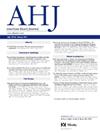Rationale and design of the ILIAS ANOCA clinical trial: A blinded-arm controlled trial for routine ad-hoc coronary function testing
IF 3.7
2区 医学
Q1 CARDIAC & CARDIOVASCULAR SYSTEMS
引用次数: 0
Abstract
Background:
Angina with nonobstructive coronary arteries (ANOCA) is a major cause of chronic coronary syndromes, affecting nearly half of patients with anginal symptoms who undergo invasive coronary angiography. ANOCA may lead to substantial symptom burden, increased risk of adverse cardiac events, increased healthcare utilization due to ongoing symptoms, repeat hospitalizations, and invasive testing. The pathophysiology of ANOCA often involves a variety of coronary disorders, such as coronary microvascular dysfunction, epicardial or microvascular vasospasm and endothelial dysfunction. While coronary function testing (CFT) can identify each of these specific endotypes, in current practice it is used as a second- or third-line diagnostic tool, delaying diagnosis which contributes to persistent symptoms and diminished quality of life. The ILIAS ANOCA clinical trial aims to enhance understanding and management of ANOCA through early routine CFT-guided management.
Methods:
After exclusion of obstructive coronary artery disease, eligible patients undergo comprehensive CFT, and will be randomized to blinding of the CFT results (control group) or disclosure of the CFT results combined with a tailored medical therapy escalation plan (intervention group). The control group will be unblinded after 1 year. The primary outcome is the mean difference in the within-subject change in Seattle Angina Questionnaire (SAQ) summary score between the groups at 6 months from baseline. Secondary outcomes include differences in SAQ-summary score and additional health-status and quality of life questionnaires at 12 and 24 months from baseline.
Clinical trial registration:
International Clinical Trials Registry Platform identifier NL-OMON20739.
ILIAS ANOCA临床试验的基本原理和设计:一项常规特设冠状动脉功能检测的盲臂对照试验。
非阻塞性冠状动脉心绞痛(ANOCA)是慢性冠脉综合征的主要原因,影响了近一半接受有创冠状动脉造影的有心绞痛症状的患者。ANOCA可能导致严重的症状负担,增加心脏不良事件的风险,由于持续的症状,重复住院和侵入性检查而增加医疗保健利用率。ANOCA的病理生理常涉及多种冠状动脉疾病,如冠状微血管功能障碍、心外膜或微血管痉挛和内皮功能障碍。虽然冠状动脉功能测试(CFT)可以识别这些特定的内窥镜类型,但在目前的实践中,它被用作二线或三线诊断工具,延误了诊断,导致症状持续和生活质量下降。ILIAS ANOCA临床试验旨在通过早期常规cft指导的ANOCA管理来提高对ANOCA的理解和管理。排除阻塞性冠状动脉疾病后,符合条件的患者进行综合CFT,随机分为CFT结果盲法组(对照组)或CFT结果披露结合量身定制的药物治疗升级计划组(干预组)。对照组将在一年后开盲。主要结果是西雅图心绞痛问卷(SAQ)总结评分在基线后6个月组间受试者内变化的平均差异。次要结局包括基线12个月和24个月时saq -总结评分和附加健康状况和生活质量问卷的差异。试验注册:国际临床试验注册平台标识符NL-OMON20739。
本文章由计算机程序翻译,如有差异,请以英文原文为准。
求助全文
约1分钟内获得全文
求助全文
来源期刊

American heart journal
医学-心血管系统
CiteScore
8.20
自引率
2.10%
发文量
214
审稿时长
38 days
期刊介绍:
The American Heart Journal will consider for publication suitable articles on topics pertaining to the broad discipline of cardiovascular disease. Our goal is to provide the reader primary investigation, scholarly review, and opinion concerning the practice of cardiovascular medicine. We especially encourage submission of 3 types of reports that are not frequently seen in cardiovascular journals: negative clinical studies, reports on study designs, and studies involving the organization of medical care. The Journal does not accept individual case reports or original articles involving bench laboratory or animal research.
 求助内容:
求助内容: 应助结果提醒方式:
应助结果提醒方式:


